人教新课标必修四Unit 2 Working the land Learning about language课件(共23张)
文档属性
| 名称 | 人教新课标必修四Unit 2 Working the land Learning about language课件(共23张) | 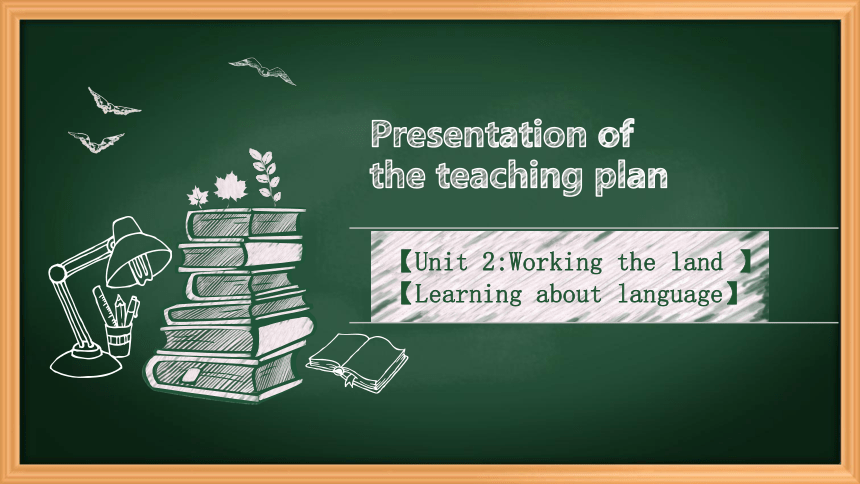 | |
| 格式 | zip | ||
| 文件大小 | 12.3MB | ||
| 资源类型 | 教案 | ||
| 版本资源 | 人教版(新课程标准) | ||
| 科目 | 英语 | ||
| 更新时间 | 2020-03-08 08:49:27 | ||
图片预览

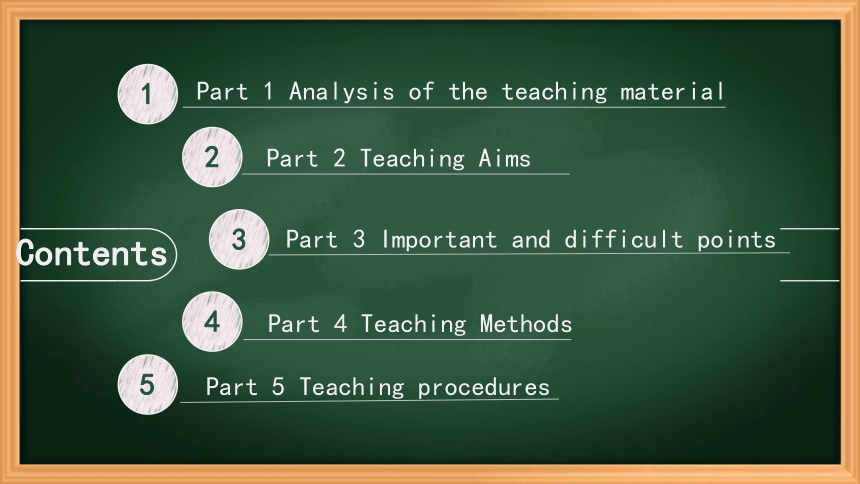
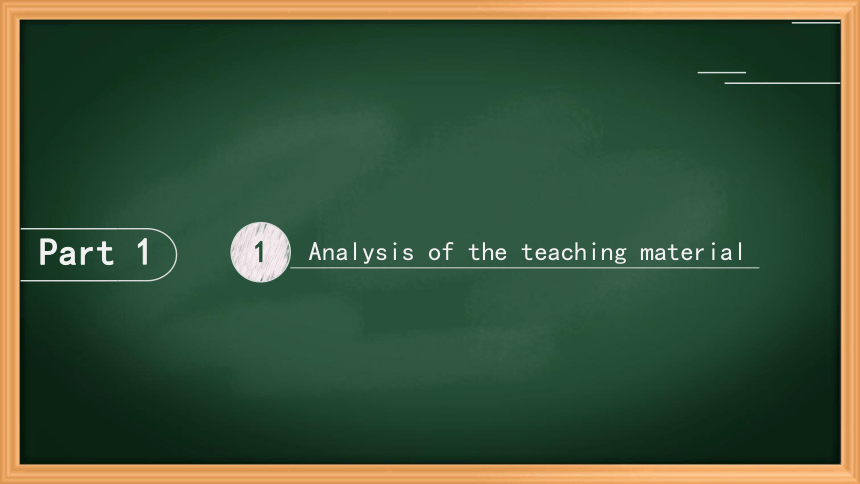
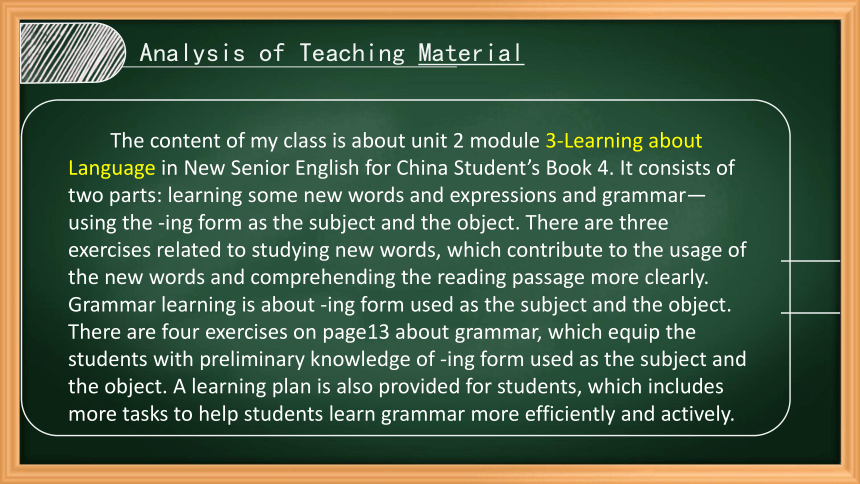
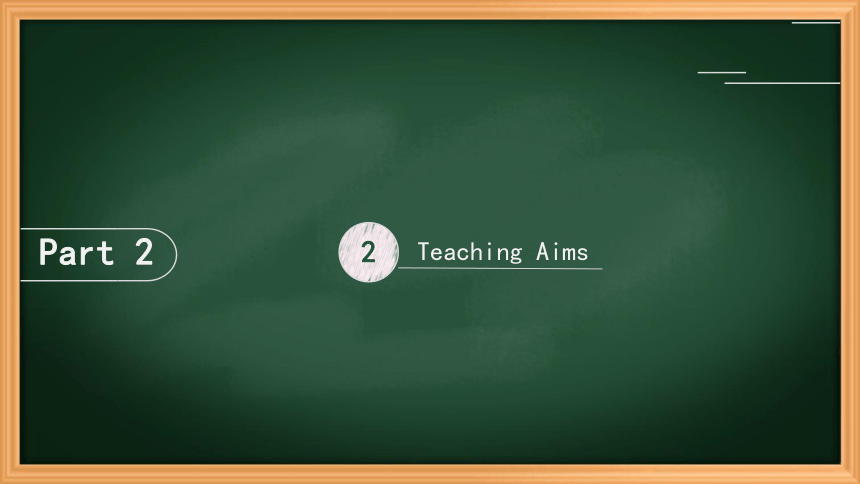
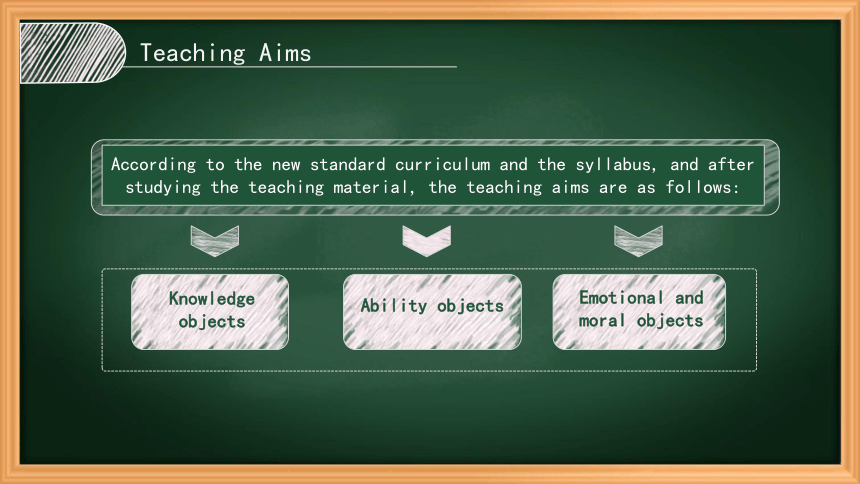



文档简介
(共23张PPT)
Presentation of
the teaching plan
【Unit 2:Working the land 】
【Learning about language】
Contents
1
2
3
4
5
Part 3 Important and difficult points
Part 4 Teaching Methods
Part 5 Teaching procedures
Part 1 Analysis of the teaching material
Part 2 Teaching Aims
Part 1
1
Analysis of the teaching material
The content of my class is about unit 2 module 3-Learning about Language in New Senior English for China Student’s Book 4. It consists of two parts: learning some new words and expressions and grammar—using the -ing form as the subject and the object. There are three exercises related to studying new words, which contribute to the usage of the new words and comprehending the reading passage more clearly. Grammar learning is about -ing form used as the subject and the object. There are four exercises on page13 about grammar, which equip the students with preliminary knowledge of -ing form used as the subject and the object. A learning plan is also provided for students, which includes more tasks to help students learn grammar more efficiently and actively.
Analysis of Teaching Material
Part 2
2
Teaching Aims
Teaching Aims
Knowledge objects
Emotional and moral objects
Ability objects
According to the new standard curriculum and the syllabus, and after studying the teaching material, the teaching aims are as follows:
Teaching Aims
Knowledge objects:
(1)To enable students to master the usage of the key words and important expressions: sunburnt, expand, circulate, struggle, export, disturbing, equip, would rather, rid...of;
(2)To enable students to get a preliminary knowledge of -ing form used as the subject and the object.
01
Teaching Aims
Ability objects :
(1)Students are expected to use some new words and expressions to make sentences correctly.
(2)Students are expected to use -ing form as the subject and the object correctly.
(3)Students are encouraged to introduce themselves and their partners orally using –ing form as the subject and the object correctly, and write a short passage to introduce a great person using –ing form as the subject and the object.
02
Teaching Aims
Emotional and moral objects :
By completing the tasks, students are expected to increase their interest in learning grammar part and set up self-confidence in speaking English.
03
Part 3
3
Important and difficult points
Important and difficult points
Important points
(1)To grasp the usage of some key words and important expressions: struggle, circulate, rid…of, would rather, equip, etc.
(2)To master how to use –ing form as the subject and the object.
(3)To learn which verbs are followed by –ing, which by the infinitive and which by both –ing form and the infinitive but have different meanings.
Important and difficult points
Difficult points
(1)To master how to use “struggle” and “would rather” correctly.
(2)To master how to use –ing form as the subject correctly.
(3)To learn which verbs can be followed by both –ing form and the infinitive but have different meanings.
Part 4
4
Teaching Methods
Teaching Methods
Situational teaching method
1
Task-based language teaching method
2
Communicative teaching method
3
Whole language teaching method
4
Part 5
5
Teaching Procedures
Teaching Procedures
Review the reading passage
StepⅠ
Yuan Longping, who has ________ face and arms, is just like those of millions of farmers, for whom he has ________(struggle) for the past five ________.When he was young, hunger was a ________ (disturb) problem. After years of research, Yuan Longping searched for a way to increase the ______of rice without expanding the area of the fields, and grows ______ is called super hybrid rice. ___________ his research, the UN has more tools to ______ the world of hunger. Now Dr. Yuan is circulating his knowledge in India, Vietnam and some __________ (develop) countries.
sunburnt
struggled
decades
disturbing
output
what
Thanks to
developing
rid
Teaching Procedures
Finish exercise 1 on Page 12 and learn the usage of some key words and expressions.
StepⅡ
1.Students are supposed to finish Ex.1 individually.
2.Teacher and students check the answers together, then teacher explains the detailed use of some key words and expressions.
(1)rid sb/sth of sb./sth
eg. He rid the house of mice.
be/get rid of sb/sth
eg. One should get rid of bad habits.
(2)circulate(v.)
eg. Blood circulates through the body.
eg. The news of his death circulated quickly.
(3)struggle (n./v.)
struggle for sth.
struggle against/with sb/sth
eg. He struggled against /with the difficulties.
eg. After a long struggle(n.), he succeeded.
(4)equip(v.)
equip sb. with sth
eg. Please equip yourself with a sharp pencil.
eg. Students should be equipped with much knowledge.
equipment(un.)
eg. The news of his death circulated quickly.
(5) would rather do A than do B.
eg. I would rather stay at home than go out.
would do A rather than do B.
prefer to do A rather than do B.
prefer doing A to doing B.
Teaching Procedures
Discover useful structure
StepⅢ
1.Teacher will show some pictures and describe them using –ing form as the subject and object.
Getting close to nature
Plants
In
my
home.
1.Planting vegetables by ourselves makes us
excited.
2.I devote most of my spare time to caring for the
plants and my little son.
3.My son enjoys watering the flowers very much.
2.Students are requested to fill in the blanks according to the pictures.
Kobe likes _____________ so much.
playing basketball
The girl is good at _________ .
dancing
__________ is bad for your health.
Smoking
It is a waste of time _________________
for a long time.
playing computer game
Teaching Procedures
Discover useful structure
StepⅢ
3.Students are expected to put four sentences into English using –ing form as subject and object.
–ing 作主语
①直接置于句首
1) 保持健康是很重要的事。
2)学习新单词非常有必要。
3)结交新朋友让我很开心。
4)嘲笑别人是不礼貌的.
Keeping healthy is important.
Learning new words is necessary.
Making new friends makes me happy.
Laughing at others is not polite.
4.Students will listen to a short passage, underline the -ing form as the subject and object and finish Ex.3 on page 13 to make a summary of verbs followed by -ing forms .verbs followed by infinitive, and verbs can be followed both by –ing form and infinitive.
An old farmer was about ________. He wanted ________ sure that his sons would stop ______ among themselves. He hoped______________ them __________ the farm successfully. The old man called his sons together and said , “My sons, I am about _________this world. You will find all that I have in the farm.
Some time later, after their father had died, the sons started ________ long hours ________ in the fields. …
Listen and fill in the blanks
to die
to make
fighting
to encourage
to leave
spending
working
to manage
Teaching Procedures
Discover useful structure
StepⅢ
5.Teacher may give further explanations of the verbs that can be followed by -ing form or infinitive or both if needed.
(1)只能后接动名词作宾语的动词,常见的有
avoid,admit, consider(考虑),enjoy,keep,
finish,suggest,appreciate,delay,deny, escape,
imagine,mind,miss(错过),practice,
cannot stand,fancy,give up,put off,
risk等。
(2)既可接动名词又可接不定式作宾语的动词,
常见的有:begin,start,continue,like,love,
prefer,mean,forget,remember,hate等。
在like, love, hate, 等动词之后,用-ing或
不定式意义上没有什么不同,只是动名词侧重表示泛指的
动作,不定式表示具体的一次性动作。
B. 在begin / start, continue之后, 用动名词和不定式,
意义无甚区别。
6.Students are asked to read another story , fill in the blanks and focus on some verbs that can be followed both by -ing form and infinitive. Teacher let the students read out the answers together and explain some unclear points.
Jane and I are good friends. One day Jane asked me to post a letter for her, I said “ No problem!” ten days later, Jane asked me whether I posted her letter or not, her sister didn’t receive the letter . I said “Yes”. But when I opened my drawer, I found Jane’s letter there. I remembered ________(post) the letter, but actually I forgot _________(post) it, which made Jane very angry. I tried _________(explain)to her, but She was still so angry with me. After a few days, Jane said to me “I’m so sorry, I didn’t mean________ (hurt) you…
posting
to post
to explain
to hurt
C.有些动词后接不定式和-ing形式意义不同。
try to do sth. / try doing sth.
mean to do sth. / mean doing sth.
stop to do sth./ stop doing sth.
forget to do sth. / forget doing sth.
remember to do sth. / remember doing sth.
go on to do sth. / go on doing sth.
Teaching Procedures
Consolidation.
StepⅣ
1.Students are expected to use one or two sentences to describe themselves and their friends.
Some useful structures
(1)I like/love/enjoy/am fond of doing sth.
(2)Doing sth.is my hobby.
(3)Doing sth. interests me most.
2. Students are requested to write a short passage to introduce a great person , referring to the sample writing on the slides.
The man I admire most is Yuan Longping. Finding ways to grow more rice has been his life goal. He devoted his life to doing research and succeeded in growing super hybrid rice. He doesn’t care about being famous. Swimming and reading are his hobbies.
Sample writing
3.Present the students’ works and let other students make some comment.
Teaching Procedures
Homework.
StepⅤ
1.Finish Ex. 2,3 on Page12 and Ex. 2,4 on Page 13.
2.Review the knowledge learned today.
3.Exchange the writing with your partner and correct mistakes.
Thank you!
Presentation of
the teaching plan
【Unit 2:Working the land 】
【Learning about language】
Contents
1
2
3
4
5
Part 3 Important and difficult points
Part 4 Teaching Methods
Part 5 Teaching procedures
Part 1 Analysis of the teaching material
Part 2 Teaching Aims
Part 1
1
Analysis of the teaching material
The content of my class is about unit 2 module 3-Learning about Language in New Senior English for China Student’s Book 4. It consists of two parts: learning some new words and expressions and grammar—using the -ing form as the subject and the object. There are three exercises related to studying new words, which contribute to the usage of the new words and comprehending the reading passage more clearly. Grammar learning is about -ing form used as the subject and the object. There are four exercises on page13 about grammar, which equip the students with preliminary knowledge of -ing form used as the subject and the object. A learning plan is also provided for students, which includes more tasks to help students learn grammar more efficiently and actively.
Analysis of Teaching Material
Part 2
2
Teaching Aims
Teaching Aims
Knowledge objects
Emotional and moral objects
Ability objects
According to the new standard curriculum and the syllabus, and after studying the teaching material, the teaching aims are as follows:
Teaching Aims
Knowledge objects:
(1)To enable students to master the usage of the key words and important expressions: sunburnt, expand, circulate, struggle, export, disturbing, equip, would rather, rid...of;
(2)To enable students to get a preliminary knowledge of -ing form used as the subject and the object.
01
Teaching Aims
Ability objects :
(1)Students are expected to use some new words and expressions to make sentences correctly.
(2)Students are expected to use -ing form as the subject and the object correctly.
(3)Students are encouraged to introduce themselves and their partners orally using –ing form as the subject and the object correctly, and write a short passage to introduce a great person using –ing form as the subject and the object.
02
Teaching Aims
Emotional and moral objects :
By completing the tasks, students are expected to increase their interest in learning grammar part and set up self-confidence in speaking English.
03
Part 3
3
Important and difficult points
Important and difficult points
Important points
(1)To grasp the usage of some key words and important expressions: struggle, circulate, rid…of, would rather, equip, etc.
(2)To master how to use –ing form as the subject and the object.
(3)To learn which verbs are followed by –ing, which by the infinitive and which by both –ing form and the infinitive but have different meanings.
Important and difficult points
Difficult points
(1)To master how to use “struggle” and “would rather” correctly.
(2)To master how to use –ing form as the subject correctly.
(3)To learn which verbs can be followed by both –ing form and the infinitive but have different meanings.
Part 4
4
Teaching Methods
Teaching Methods
Situational teaching method
1
Task-based language teaching method
2
Communicative teaching method
3
Whole language teaching method
4
Part 5
5
Teaching Procedures
Teaching Procedures
Review the reading passage
StepⅠ
Yuan Longping, who has ________ face and arms, is just like those of millions of farmers, for whom he has ________(struggle) for the past five ________.When he was young, hunger was a ________ (disturb) problem. After years of research, Yuan Longping searched for a way to increase the ______of rice without expanding the area of the fields, and grows ______ is called super hybrid rice. ___________ his research, the UN has more tools to ______ the world of hunger. Now Dr. Yuan is circulating his knowledge in India, Vietnam and some __________ (develop) countries.
sunburnt
struggled
decades
disturbing
output
what
Thanks to
developing
rid
Teaching Procedures
Finish exercise 1 on Page 12 and learn the usage of some key words and expressions.
StepⅡ
1.Students are supposed to finish Ex.1 individually.
2.Teacher and students check the answers together, then teacher explains the detailed use of some key words and expressions.
(1)rid sb/sth of sb./sth
eg. He rid the house of mice.
be/get rid of sb/sth
eg. One should get rid of bad habits.
(2)circulate(v.)
eg. Blood circulates through the body.
eg. The news of his death circulated quickly.
(3)struggle (n./v.)
struggle for sth.
struggle against/with sb/sth
eg. He struggled against /with the difficulties.
eg. After a long struggle(n.), he succeeded.
(4)equip(v.)
equip sb. with sth
eg. Please equip yourself with a sharp pencil.
eg. Students should be equipped with much knowledge.
equipment(un.)
eg. The news of his death circulated quickly.
(5) would rather do A than do B.
eg. I would rather stay at home than go out.
would do A rather than do B.
prefer to do A rather than do B.
prefer doing A to doing B.
Teaching Procedures
Discover useful structure
StepⅢ
1.Teacher will show some pictures and describe them using –ing form as the subject and object.
Getting close to nature
Plants
In
my
home.
1.Planting vegetables by ourselves makes us
excited.
2.I devote most of my spare time to caring for the
plants and my little son.
3.My son enjoys watering the flowers very much.
2.Students are requested to fill in the blanks according to the pictures.
Kobe likes _____________ so much.
playing basketball
The girl is good at _________ .
dancing
__________ is bad for your health.
Smoking
It is a waste of time _________________
for a long time.
playing computer game
Teaching Procedures
Discover useful structure
StepⅢ
3.Students are expected to put four sentences into English using –ing form as subject and object.
–ing 作主语
①直接置于句首
1) 保持健康是很重要的事。
2)学习新单词非常有必要。
3)结交新朋友让我很开心。
4)嘲笑别人是不礼貌的.
Keeping healthy is important.
Learning new words is necessary.
Making new friends makes me happy.
Laughing at others is not polite.
4.Students will listen to a short passage, underline the -ing form as the subject and object and finish Ex.3 on page 13 to make a summary of verbs followed by -ing forms .verbs followed by infinitive, and verbs can be followed both by –ing form and infinitive.
An old farmer was about ________. He wanted ________ sure that his sons would stop ______ among themselves. He hoped______________ them __________ the farm successfully. The old man called his sons together and said , “My sons, I am about _________this world. You will find all that I have in the farm.
Some time later, after their father had died, the sons started ________ long hours ________ in the fields. …
Listen and fill in the blanks
to die
to make
fighting
to encourage
to leave
spending
working
to manage
Teaching Procedures
Discover useful structure
StepⅢ
5.Teacher may give further explanations of the verbs that can be followed by -ing form or infinitive or both if needed.
(1)只能后接动名词作宾语的动词,常见的有
avoid,admit, consider(考虑),enjoy,keep,
finish,suggest,appreciate,delay,deny, escape,
imagine,mind,miss(错过),practice,
cannot stand,fancy,give up,put off,
risk等。
(2)既可接动名词又可接不定式作宾语的动词,
常见的有:begin,start,continue,like,love,
prefer,mean,forget,remember,hate等。
在like, love, hate, 等动词之后,用-ing或
不定式意义上没有什么不同,只是动名词侧重表示泛指的
动作,不定式表示具体的一次性动作。
B. 在begin / start, continue之后, 用动名词和不定式,
意义无甚区别。
6.Students are asked to read another story , fill in the blanks and focus on some verbs that can be followed both by -ing form and infinitive. Teacher let the students read out the answers together and explain some unclear points.
Jane and I are good friends. One day Jane asked me to post a letter for her, I said “ No problem!” ten days later, Jane asked me whether I posted her letter or not, her sister didn’t receive the letter . I said “Yes”. But when I opened my drawer, I found Jane’s letter there. I remembered ________(post) the letter, but actually I forgot _________(post) it, which made Jane very angry. I tried _________(explain)to her, but She was still so angry with me. After a few days, Jane said to me “I’m so sorry, I didn’t mean________ (hurt) you…
posting
to post
to explain
to hurt
C.有些动词后接不定式和-ing形式意义不同。
try to do sth. / try doing sth.
mean to do sth. / mean doing sth.
stop to do sth./ stop doing sth.
forget to do sth. / forget doing sth.
remember to do sth. / remember doing sth.
go on to do sth. / go on doing sth.
Teaching Procedures
Consolidation.
StepⅣ
1.Students are expected to use one or two sentences to describe themselves and their friends.
Some useful structures
(1)I like/love/enjoy/am fond of doing sth.
(2)Doing sth.is my hobby.
(3)Doing sth. interests me most.
2. Students are requested to write a short passage to introduce a great person , referring to the sample writing on the slides.
The man I admire most is Yuan Longping. Finding ways to grow more rice has been his life goal. He devoted his life to doing research and succeeded in growing super hybrid rice. He doesn’t care about being famous. Swimming and reading are his hobbies.
Sample writing
3.Present the students’ works and let other students make some comment.
Teaching Procedures
Homework.
StepⅤ
1.Finish Ex. 2,3 on Page12 and Ex. 2,4 on Page 13.
2.Review the knowledge learned today.
3.Exchange the writing with your partner and correct mistakes.
Thank you!
同课章节目录
